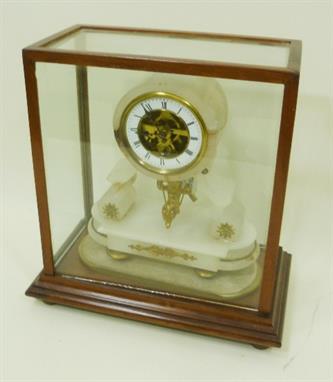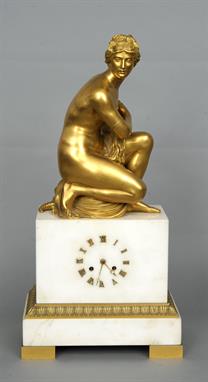A 19th century French mantel clock, fitted an eight day movement striking on a bell, in a gilt brass case with Sevres style porcelain panels, 34 cm high See illustration Condition report Report by RB Case is gilt brass, there is one swag detached from the right hand side, otherwise generally good, porcelain panels good, no back plate (probably never was), very dusty, from a local private client.
We found 96232 price guide item(s) matching your search
There are 96232 lots that match your search criteria. Subscribe now to get instant access to the full price guide service.
Click here to subscribe- List
- Grid
-
96232 item(s)/page
19th Century French ebonised cased mantel clock, the case of rectangular stepped form with applied ormolu wreath and foliate mount, off-white enamel dial with Roman and Arabic numerals, brass movement striking on a bell, 36cm high Condition Report: Case - Block feet are old replacements, finial to top is a probable replacement. Dial - some restoration at edge between 5 and 6, various hairlines around other areas of rim - This is a cosmetic report only we do not comment on the workings of clocks -**
19th Century Continental porcelain figural cased mantel clock, probably Wallendorf, decorated with four putti, the white enamel dial with Roman and Arabic numerals and retailers mark for Nathan & Co, French brass movement striking on a bell, 39.5cm high Condition Report: Case - reclining cherub has two fingers missing from left hand, left side cherub has one finger missing from right hand, right side cherub has one finger missing from each hand, some flowers and leaves have chips - most of which are relatively superficial
19th Century French ormolu cased mantel clock by Vincent et Cie and retailed by Howell, James & Co having Sevres type porcelain panels and dial with foliate and classical decoration, the case surmounted with an urn shaped pediment, dial with Roman numerals, brass movement striking on a bell, 51.5cm high Condition Report: We do not comment on the workings of clocks -** General condition consistent with age
Regency brass inlaid mahogany mantel clock by William James of Bristol, the case with brass top handle, inlaid star decoration, off-white dial with Roman numerals, standing on brass ball feet, brass single fusee movement, 30cm high Condition Report: Case - some blistering to the veneers on left side of case, square of moulding approximately 0.75cm to left side of ebonised band above dial missing, rear door has splits above top hinge and below left hinge, some superficial bruising etc. Dial - one hand
Late 19th/early 20th Century French brass framed oval cased four glass mantel clock by Henry Marc of Paris, the white enamel dial with Roman numerals and visible anchor escapement, mercury pendulum, brass movement striking on a bell, 35.75cm high Condition Report: Case - brass is/was gilded and lacquered so is therefore rather stained and rubbed. Dial - 2cm hairline crack at edge between 5 and 6 - This is a cosmetic report only we do not comment on the workings of clocks -** General condition consistent with age
A LATE 19TH CENTURY FRENCH ORMOLU AND ROSE POMPADOUR PORCELAIN MANTEL CLOCK BY GAY VICARINO & CO OF PARIS, the rectangular case surmounted with doves, trophies and wreath, within an acanthus leaf border, the dial and panels painted with cherub, Venus and Cupid, and ribbon-tied garlands and trophies, twin lion mask and ring handles to the sides, on a laurel leaf base raised on a plinth cast with panels of vitruvian scrolls and on toupie feet; the pendulum movement striking the hour and half hour on a bell, stamped to the movement G.V and to the movement and case No. 13815, complete with a velvet lined giltwood stand, clock 29cm high, overall 32.5cm high. See illustration
A PRESENTATION EQUESTRIAN MANTEL CLOCK WITH MUSICAL CHIME LYUBAVIN, ST. PETERSBURG,1904, 84 STANDARD Height 45 cm, base 40.5 by 25 cm. The green-grey hardstone chiselled to imitate a rocky outcrop, centred with a circular white dial with black Roman numerals within plain silver bezel and applied with dedication plaque “For distinguished conduct in Russo-Turkish war of 1877–1878”, Roman and Arabic numerals “XXV” and “1863.1888» and the badge of the Order of St. George and enamelled epaulettes, mounted with a silver cast and finely chased figure of a horse with mounted artilleryman; the wooden base containing musical movement with a commemorative plaque engraved in Cyrillic “From colleagues and comrades-in-arms of the Life-Guards of the 1st Artillery Squadron and Field Artillery Battalion” and a list of sixty officers. This fine clock with an equestrian figure was presented to an unnamed distinguished officer who served in the Life-Guards of the 1st Artillery Squadron and Field Artillery Batallion. The red and white colours of the enamel epaulettes on the clock correspond to the colours of the wrist-cuffs and welts of the uniform of this military unit. The clues to the identity of the officer can be found in the names of his colleagues listed on the plaque. Among them: General-Major M. Meklenburg-Strelitskii (Commander of the Squadron 1903–1908), Colonels V. Lekhovich, N. Demidov, E.Smyslovskii and N. Il’kevich, Captain G.Veshnyakov and Staff-Commander N. Belyaev. The military register proves that these officers at some point in their military career all served in the Life-Guards of the 1st Artillery Squadron. The majority of them were still serving in that Squadron in 1904 when the clock was presented. The Life-Guards unit of the 1st Artillery Squadron was founded in 1796 and participated in the Russo-Turkish war (1877–1878) and World War I; the Field Artillery Battalion was founded in 1898 and disbanded in 1918. Both units were based in St. Petersburg. The dedication plaque “For distinguished conduct in Russo-Turkish war of 1877–1878” indicates that the officer to whom the clock was presented, also participated in that war and was awarded the Order of St. George. Research into the Order’s knights who would match these criteria has produced only one name – that of Colonel Alexander Onoprienko. Alexander Onoprienko (1827 – after 1917) was awarded the 4th Class Order of St. George in 1878. By 1904, he was the Commander of the Life-Guards 1st Artillery Squadron for 25 years (from 1879), and in 1888 he also took command of the 2nd Artillery Squadron. He participated in the suppression of the Polish rebellion in 1863 and was in charge of the St. Petersburg military district from 1895. Onoprienko resigned from this post on the 12th August 1904. Therefore, it is reasonable to assume that the present lot was a leaving present from his colleagues. The history of the Russian army and the dramatic events of the first quarter of the 20th century are all reflected in this clock, which makes it not only a remarkable timepiece and work of art, but above all a historical artifact of particular importance to collectors.
A late 19thC gilt metal mantel clock, the circular Roman numeric dial flanked by a gentleman playing lyre and a harp, surmounted by a torch and garland on a block rectangular base raised with garlands and musical instruments on shaped feet, presented under a glass glazed dome, on a gilt wood base with key, 23cm high.
A French mantel clock, c.1890, the movement by Vincenti, striking on a bell, the marble column surmounted by a bronze bust of Bacchus, a gilded putto and a mask, 55cm high CONDITION REPORT: No obvious faults. Base is stable, bit of movement on pedestal. Some wear to finish and gilded parts. Holes on either side of base, suggesting missing something. Please view additional images (upon request).
A 19th century French Ormulu Mantel Clock, Circular case surmounted with applied tied ribbon, laurel leaf and roses and depicting a quiver of arrows and a torch. The hand painted porcelain face plate depicting sprays of flowers within pink border and Roman dial. Four further porcelain panels depicting a 19th century figure and floral sprays, the clock supported on lion claw feet. The signed and numbered movement striking on a bell initialled JBD on the movement and the pendulum. JBD is the monogram of Jean Baptiste Delettrez.
A 19th century gilt bronze mounted mahogany mantel clock The finial mounted domed top above the pierced gilt bronze face with silvered chapter ring with Roman and Arabic numerals and twin winding apertures, flanked by trailing gilt bronze caryatids, standing on an acanthus cast plinth base with bracket feet. 35.5 cms high. CONDITION REPORTS: Generally in good condition, some general wear.
A 19th century gilt bronze and marble mantel clock The ribbon tied and floral swag mounted oval face painted with cherubs, the white enamel dial with Roman numerals above a separate patent date and days aperture, over the scroll and shell cast central section and white marble plinth presentation plaque, standing on florally cast bun feet. 57 cms wide. CONDITION REPORTS: Some gilt loss/wear, two feet lacking, some fritting to marble, some slight wear to dials, name to dial rubbed, general wear.
A 19th century cloisonne decorated bronze mantel clock The domed finial mounted top above the cloisonne decorated dial with Arabic numerals and twin winding apertures over a further cloisonne decorated panel, flanked by turned columns, standing on a spreading plinth base with bun feet. 28.5 cms high. CONDITION REPORTS: Some losses and restorations to cloisonne, general wear, not guaranteed in working order.
A 19th century ormolu mounted white marble mantel clock The square section body with Roman numerals, surmounted with a female figure astride a turtle. 62 cms high. CONDITION REPORTS: Some slight chipping and fritting, some patination wear, back cover lacking, pendulum lacking, clock not guaranteed in working order.
A 19th century French cloisonne decorated brass four glass mantel clock The cloisonne decorated domed stepped top above the jewel encrusted dial with Arabic numerals flanked by cloisonne decorated uprights above a stepped plinth base. 33 cms high. CONDITION REPORTS: Some enamel chips/losses, some scuffing and scratching, general wear, clock not guaranteed in working order.
A 19th century French cloisonne decorated ormolu mantel clock The pierced domed top above a seated cherub over the cloisonne decorated dial with Roman numerals and twin winding apertures, flanked by two cherubs leaning on columns above the stepped plinth base with bun feet. 39 cms high. CONDITION REPORTS: Some general wear, some elements slightly loose, bezel lacking from front, pendulum lacking, some slight enamel wear.
-
96232 item(s)/page




























































